(February 1929, 20m) Director: Lewis R. Foster Released: MGM, May 18, 1929 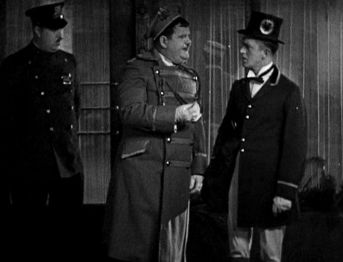 In Double Whoopee Stan and Ollie are employed as the footman and doorman of a distinguished hotel, producing the chaos and accumulating violence we've come to expect. Though amusing, this short doesn't feel particularly progressive in light of their work through the previous year. The visiting Prince, played by Captain John Peters, was a spoof of Erich Von Stroheim, whose real-life stand in was Peters himself.    (February/March 1929, 20m) Director: Lewis R. Foster Released: MGM, October 19, 1929 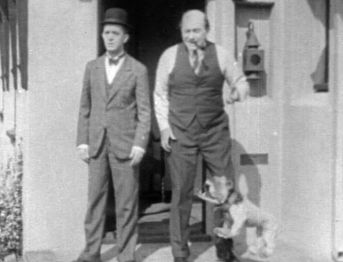 Stan and Ollie appear as inept bailiffs, attempting to take a radio from Edgar Kennedy. Many of the gags and situations feature in many of their other movies (even Kennedy's bizarre puppet pit bull terrier is a direct lift from the Tyron-Hardy short Along Came Auntie), but what really makes Bacon Grabbers special is the high energy and chemistry between the leads. Stan and Ollie have really got their characters and rapport down pat by this point, and it shows. A point of trivia is that Hardy, through title cards, refers to Stan as having 'hot Corsican blood.' Although a throwaway gag, audiences may not have been aware that Stan was English at this time.    (March 1929, 21m) Director: Lewis R. Foster Released: MGM, December 14, 1929 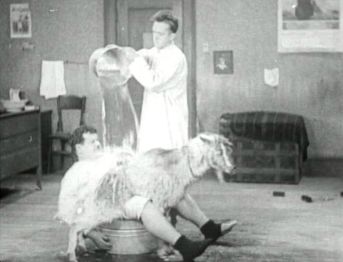 It seems oddly appropriate for their bawdier silent work that Laurel and Hardy should bow out of non-talkies with arguably their lewdest work of all. Angora Love, where even the title has outrageous connotations, even today, features Stan and Ollie suspected of inappropriate conduct by landlord Edgar Kennedy. At one point Kennedy knocks on their apartment door to tell them he runs a respectable hotel... only for a sailor and a prostitute to walk behind him. It's bawdy, shocking stuff, a world away from later features, and a definite strike against those who like to claim that Stan and Ollie's comedy was always purely innocent. Sure, the characters themselves are, but the actions and suspicions of those around them aren't, with the duo cast as na�ve babes in an adult world they do not fully understand. Perhaps appropriately for the final silent, we also get a sixth 'someone falls into a previously unseen mud hole' gag, though the rest of the short is new material, looking to the future, not to the past. While about to enter into sound and reach even greater heights, Hardy's personal life was hitting new lows. His marriage to first wife Myrtle was disintegrating, largely due to her alcoholism, and a press cutting from March 1929 detailed him being sued by a fellow actor. Tyler Brooke had appeared with Hardy in seven shorts, three of which had Stan's involvement as writer or director. Brooke stated that Hardy broke his arm with a billiard cue at a pool hall, while Hardy contested that he'd taken Brooke's calling him a 'son of a bitch' as a slur on his mother. (Ironically their first sound short, begun the same month, would feature Stan and Ollie coming home from a pool hall). Hardy was reputedly a sweet-natured man off screen, so the incident - in which Brooke sued for $109,570 - would seem to be an aberration. Possibly connected to this was that Brooke didn't work for Hal Roach again until the Laurel and Hardy team had left the studio in the 1940s... fourteen years later Brooke would kill himself by carbon monoxide poisoning.     (March/April 1929, 21m) Director: Lewis R. Foster Released: MGM, May 4, 1929 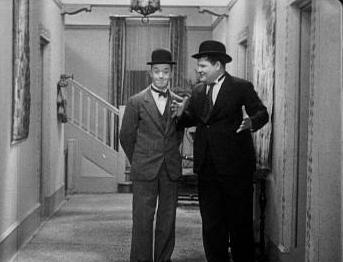 Sound on film had been achieved as early as 1900, but it took years before the technology was able to produce a consistent, synchronised soundtrack. The first feature film to use sound is often credited as The Jazz Singer, though even with that release the use of synchronised dialogue (as opposed to just music) was limited. Yet by 1929 the medium was becoming commonplace, and it's with this wittily-titled short that Laurel and Hardy made the transition. Rumours abound of silent film stars that didn't make the transition, of screen sex symbols that had squeaky voices that made audiences laugh. Thankfully Stan Laurel and Oliver Hardy have the perfect voices to capture their screen personas. Ollie begins the short by detailing in his rich southern gentleman voice the dinner his wife will prepare for both he and Stan. 'Any nuts?' is Stan's first-ever line in a Laurel and Hardy film, coming through the screen in his bizarre transatlantic northern English/pseudo-American hybrid. It's a truly unique, reedy voice, ideally personifying Stan as we've known him throughout the silents, just as Hardy manages to capture all of his onscreen character's pomposity with his delivery. There are clear signs that this is the infancy of the sound film movement - scenes here are rigidly blocked so as to get all the speakers within range, and the editing suffers as a result - but it's a shockingly ambitious entry for their first 'talkie', with Hardy's wife at one point shouting at her husband to the punctuation of a record. Essentially a farce - Hardy's wife leaves him, and when the neighbour's wife innocently ends up in just her nightgown neither Ollie's returning wife or his neighbour will believe it - Unaccustomed As We Are perhaps suffers from a weak payoff, but has much to recommend it. On a point of trivia then we get the debut of Hardy's primary catchphrase during the Roach years... and it's not the one that begins 'Well here's another...' Ollie's plaintive, almost primal 'why don't you do something to help me?' gets its first utterance here and the character says it five more times over the next six years, plus another eight times as the paired-down 'do something to help me!' Add to that an even shorter 'do something to help!' from Any Old Port!, a variance of 'why don't you do something for me?' said twice in They Go Boom! and 'Little Ollie' saying the primary phrase in Brats and there you have it, eighteen instances, three more than that of the 'nice mess' routine (of which more later).     (April 1929, 20m) Director: Lewis Foster Released: MGM, June 1, 1929 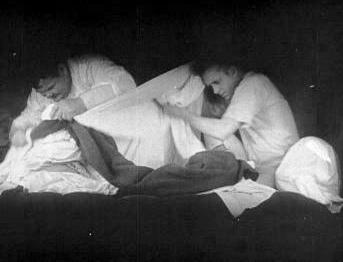 What's striking about the first half dozen 'talkie' shorts is that Stan and Ollie appear to struggle with the medium as if they need to relearn their craft for sound. This wouldn't be so unusual were it not for the fact that they're clearly talking fluidly and in character in many of the later silents. Simple lip-reading can reveal that the two stars really are saying what's on the title cards in many instances, and some of the later silents are like sound films, just that we can't hear the dialogue. With the bulk of dialogue in the shorts improvised, then with entries like Men O'War and The Hoose-Gow then there's the sense that they didn't initially transfer to sound with the ability to ad-lib fluidly. This is even more surprising considering how verbal the previous entry is, but here Hardy complains that Stan is 'crowding' him on no less than six occasions. Berth Marks is minimalist by even Laurel and Hardy standards - the two are musicians, trying to share a train berth but failing miserably. Perhaps the best joke is the pay off that their antics have set off a train-wide clothes ripping fight without their knowledge, but it's all very slight in scope. In 1930 the short was chosen to act as a phonetic four-reeler for the French, German and Spanish markets when combined with material from The Laurel-Hardy Murder Case. Aware of the popularity of Laurel and Hardy in European territories, but concerned that the films wouldn't translate, the two stars recreated several of their films - often with completely new casts - speaking the foreign languages phonetically. Eight films were made in Spanish, with the aforementioned hybrid feature (Noche De Duendes) joining Ladrones (Night Owls), La Vida Nocturna (Blotto), Tiembla y titubea (Below Zero), Radioman�a (Hog Wild), De Bote En Bote (Pardon Us), Los Calaveras (A Be Big! /Laughing Gravy hybrid) and Politiquerias (Chickens Come Home-). Admirers of Laurel and Hardy are fortunate in that only Radioman�a is a lost film, with the other seven pictures existing. Adding to this list was a hybrid remake in French (Feu Mon Oncle) along with French versions of Brats (Les Bons Petits Diables), Blotto (Une Nuit Extravagante), Hog Wild (Pêle-Mêle), Pardon Us (Sous Les Verrous) and a Be Big!/Laughing Gravy hybrid (Les carrotiers). Of these, only Les carrotiers still exists, with Une Nuit Extravagante incomplete and the rest missing. The Berth Marks/Laurel-Hardy Murder Case feature was also one of just three remade as a German film (Spuk um Mittermacht) along with Gluckliche kindheit (Brats) and Hinter Schloss und Riegel (Pardon Us). Of these, Spuk um Mittermacht fares the best with around 30 minutes of footage recently rediscovered in 2004. The German Pardon Us exists as trailer footage only, while the German Brats remains a completely missing film. These listings are only those films known to have been made. With records of the time scarce it's entirely possible that others were made, and indeed when writing to a fan in 1964 it was Stan's recollection that eight films had been made in four foreign languages. Of making the foreign versions Stan remembered that they 'called in four interpreters, FRENCH, SPANISH, GERMAN & ITALIAN who translated the script & engaged a different cast for each version, excluding of course L&H & principal characters such as Jimmy Finlayson etc. The interpretor [sic] read each scene to us word by word & we wrote it on a blackboard as it sounded to us (Phonetic system) these boards were placed in back of each of us (out of camera range) so we had no difficulty in speaking the lines in every language.'    (May 1929, 19m) Director: Lewis R. Foster Released: MGM, June 29, 1929 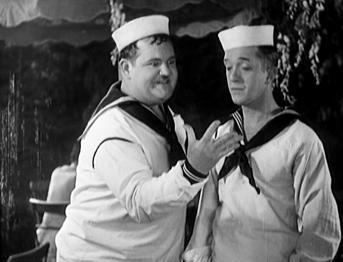 There's a certain amount of primitivism in this short, from the noisy cameras on location to what sounds like occasional off-camera laughing of the crew. There's also a rough, 'off the cuff' feeling to much of the gags and situations, not helped by the fact that the soda fountain scene (reprised from Should Married Men Go Home?) seems so polished. However, this is not to criticise... while Men O'War, complete with a variable print, does look like something resembling a home movie in 2009, there's much charm and laughs to be had from it. It's also the debut of Finlayson's 'd'ohhhhhhhhhh' catchphrase, reputedly invented when the actor went to say 'damn' and remembered that they'd switched over to sound, adjusting himself accordingly. There's no indication on film that this was actually the case, but as we'll see in their next short, bad language in Laurel and Hardy most definitely was used...    (June 1929, 116m) Director: Chuck Reisner Released: MGM, November 23, 1929 By this stage in their careers Laurel and Hardy were so successful that they made two cameos in feature length movies during 1929. The first was this, The Hollywood Revue of 1929, written and filmed in the Spring, with Stan and Ollie's cameo being filmed much later in June. Oscar-nominated for Best Picture at the time of its release, the film showcased many MGM stars, including Joan Crawford, Lionel Barrymore, Buster Keaton, Marion Davies and Jack Benny. The film itself is essentially plotless: the basic conceit is that the stars involved are putting on a 'revue' performance of songs and turns, playing to an audience. In the middle of the film Stan and Ollie get a six minute cameo as a hapless magician's act where everything goes wrong. Although some segments of the film were shot in Technicolor (including the entire cast, minus Laurel and Hardy, performing 'Singin' In The Rain' as the finale) the magician sequence was in black and white. What makes the film so lacking in atmosphere is that all of the acts we see are supposedly performing to a theatre audience, yet not even some form of canned laughter is provided to convey this illusion. Consequently all of the gags and routines are performed to dead silence, and the medium of film is not utilised at its fullest by there being no incidental music to cover the gaps. As a result it neither fully works as a movie nor as a 'live performance'. Although Laurel and Hardy's routine is the best thing in the picture, The Hollywood Revue of 1929 was hardly the highlight of anyone's career, and its Oscar nomination remains inexplicable.   (May/June 1929, 19m) Director: James Parrott Released: MGM, August 10, 1929 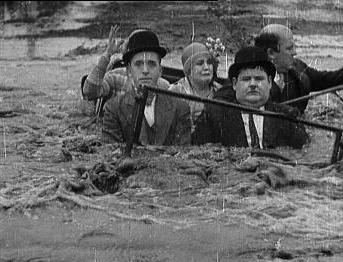 Arguably their first truly classic sound film as Stan and Ollie try and take their wives on a picnic... and fail abysmally. In just trying to drive down the street (where we get the seventh 'someone or something falls into a previously-unseen mudhole', possibly its funniest use here) Stan and Ollie inflict violence upon themselves, their neighbours and their Uncle's gout-ridden bandaged foot. The Uncle is question is another appearance from Edgar Kennedy, here going into cinema history as the first man to say 'shit' in the movies. There's much debate about which was the first film to use profanity... the f-word was first featured in a 1933 cartoon called Bosko's Picture Show (which coincidentally featured a Stan and Ollie parody as 'Haurel and Lardy') though afterwards audiences had to wait until the 1960s to hear it again. Other swearwords first made their breakthrough in the 1970s, yet despite this, 12 minutes into Perfect Day (just after the dog is thrown out of the car) Kennedy improvises an 'oh, shit!' Apparently not noticed by the team working on it, it's clear evidence that the switch to sound filming took the cast some getting used to. Also of note is that this is the first of their films to experiment with comedy sound effects for violence. While a kick up the backside in Unaccustomed As We Are (and the next film) would produce no sound other than that entirely naturalistic, in Perfect Day we get a great comedy clatter as Stan is hit over the head with a clutch. It was claimed to have got one of the biggest laughs in a Laurel and Hardy film and so it became a regular fixture of their work.     (June/July 1929, 20m) Director: James Parrott Released: MGM, September 21, 1929 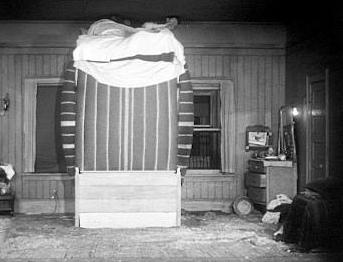 They Go Boom! sees Stan and Ollie as bachelors again, sharing a bed in a run-down apartment block run by Charlie Hall. With Hardy ill and Stan's bedside treatments only making him worse, the series increases its level of surrealism. Whereas before we'd occasionally seen crushed midget policemen or hyper-real throbbing toes, here Ollie accidentally inhales air from their inflatable bed and gets a distended, outsized belly as a result. Later, the same bed gets inflated to a ceiling-high level in a lesser-seen but striking short.     (July-September 1929, 104m) Director: Lionel Barrymore Released: MGM, May 10, 1930 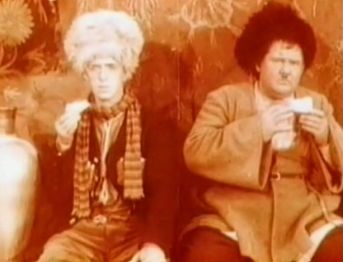 The second feature film of the year with a Stan and Ollie cameo, the duo appeared in The Rogue Song for the only time in colour, save for 1941's The Tree In A Test Tube. Sadly the film no longer exists, save for fragments. Laurel and Hardy were listed as making ten comic appearances throughout the film, but only one - where the duo are chased into a cave by a bear - remains in the archives, along with shots of them both from the existing trailer. A romantic musical about the love between a bandit and a princess, The Rogue Song was set in 1910 Russia. Despite the credit for Barrymore, all of the cameo scenes with Laurel and Hardy were helmed by Hal Roach. The image above is, of course, duo colour rather than the Technicolor that the film was produced in. The reason for this is that certain elements only exist in this state, and, ironically, have a greater clarity of picture than the full colour bits. I did initially take a screencap of a colour segment but what remains of those elements is very soft and muddy, so I decided to bring to the site the best available image that I could.    (August/September 1929, 18m) Director: James Parrott Released: MGM, November 16, 1929 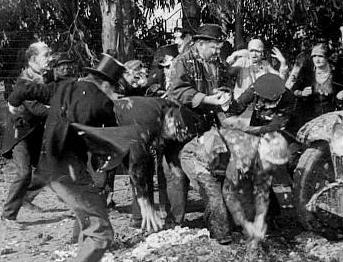 Something of a backward-looking film, with a return to the pie (or, in this case, rice) throwing finale of The Battle of the Century two years earlier. It seems curiously dated even by 1929 standards, though by Laurel's account the lack of initial experimentation in the early sound films was deliberate. Writing to a fan in 1962 he recalled that 'In those early sound films [...] we purposely didn't talk much - wanted to get familiar with the new medium before discarding the knowledge we were experienced with. I think that's why we survived the advent of sound - many of the good old silent comics, all of a sudden thought they were actors & resorted to dialogue comedy which they knew nothing about - hence they went out of business.' In terms of progression then comic sound effects for violence are now the norm, and with Stan being able to swallow an apple whole the series continues pitching towards Stan and Ollie as cartoons in human form.    (October/November 1929, 20m) Director: James Parrott Released: MGM, January 4, 1930 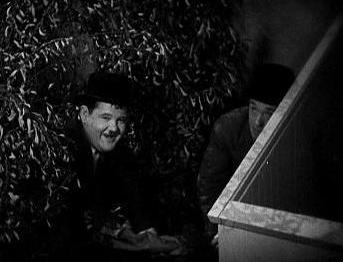 It's possible to argue that two things contributed the most to Laurel and Hardy's high standard of work: sound and the Depression. While their body of work is much enriched by the silent shorts, the transition to sound saw the duo have voices that were the perfect embodiment of their characters. As for the Depression, while Stan and Ollie had played vagrants before - indeed, they did so in their second Roach short together - it was to become a regular fixture of their onscreen personas from hereon in, beginning with the following year's Below Zero. Their status as vagrants in Night Owls could be purely coincidental, though the Wall Street crash of October 24th - October 29th 1929 occurred while the film began shooting. Night Owls sees Police Officer Kennedy - Edgar in the last of his appearances until 1943 - down on his luck after a record number of burglaries get past him on his watch. When he stumbles upon Stan and Ollie as vagrants sleeping on a park bench he offers them a choice... either help him or go to jail. With no alternative, the duo follow Kennedy's plan to break into the Police Chief's home and allow Kennedy to 'arrest' them, with the promise that 'Kennedy will fix it.' What this actually entails remains unknown as Kennedy gets knocked unconscious along the way, and recovers as the boys make their getaway, leaving himself framed. Yet despite retaining their freedom, it's a somewhat distressing subtext of the film that Stan and Ollie are trapped through their own circumstances and powerless to change things around them. Whereas Chaplin played a tramp as a counterpoint to society, here Laurel and Hardy are society, and are presented with no realistic hope of escaping their fate. The central plot was one that had been with Stan since his pre-film days, where he'd performed the sketch as 'The Nutty Burglar' in 1912. The idea remained such a fond one for the actor that he rewrote it as 'On The Spot' for both of them to perform in 1953 after their film career was over. Another reminder of Stan's past was around at the time, as Hal Roach had employed Stan's old employer, Fred Karno, believing him to be a gag man that could make the films even more successful. Sadly, the association was not to be fruitful, and when Roach realised that Karno was more of a manager than a gag man he let him go during the making of Below Zero. A further point of note is that this was the first Laurel and Hardy film to feature the 'Kuku' theme. Composed in 1928 by Thomas Marvin Hatley as a timecode for KFVD (a radio station based on the Roach Studios lot) it was overheard by Stan who asked to use it for the Laurel and Hardy theme. It was reworked and used here, and became a standard fixture from Brats onwards. However, due to rereleases of their films, variations of the theme can often be heard in their films all the way back to Duck Soup, giving a false impression that it was a regular fixture from the beginning. The first Laurel and Hardy movie to be filmed as a foreign language edition, the Spanish Ladrones contains one of the most charming scenes in the whole Laurel and Hardy canon. The moment where both men are pretending to be cats (or, here, gatos) has Ollie doing his best 'aching jaw after being hit by a brick' acting, causing Stan to momentarily appear to be about to genuinely laugh at Hardy's comic performance. He covers it by going into character and pointing dopily at Hardy, who in turn tries to cover it by giving him a characteristic hand swipe. The scene then cuts as a smile plays over Ollie's face, almost as if the ludicrousness of the situation - two grown men on their hands and knees pretending to be cats, and in Spanish - has hit them. It's a rare chance to see them almost break character, and show that they really did make each other laugh. Also notable in Ladrones is an alternate ending where both men are arrested, and attempt to make a getaway, before the police car falls into one of those previously-unseen mud holes.     (December 1929, 26m) Director: James Parrott Released: MGM, February 8, 1930 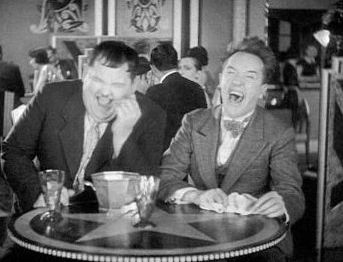 The first three-reeler comedy for Laurel and Hardy, a format they would return to nine times over the following five years. The Hal Roach studios made no extra money from their distribution deal over this arrangement, proving that here was a studio that was interested in product over profits. Notable again are the foreign language versions - they feature additional acts in the Rainbow Club, plus a drunken singing session with Stan and Ollie. Yet perhaps more importantly, they give an idea of what the film would really have sounded like when originally shown. The original print of Blotto is lost, as with many of the shorts, and what remains is a 1937 reissue that placed incidental music from the feature films over the top. The practise was effective as a redistribution tool, and indeed, the sound shorts from 1929 that didn't undergo this practise get shown a lot less on television repeat schedules. Also notable is that damage to the negative saw parts of the action get trimmed - at one point Mrs. Laurel switches on a fan in response to Stan's request for 'fresh air'... this can be seen in the foreign prints. In terms of trivia then with the foreign language version containing song, this is the first instance of Oliver Hardy singing on film. Hardy would go on to do this in twenty one further films, ranging from complete songs (such Way Out West/The Flying Deuces) to just singing a bit of melody (Our Wife/A-Haunting We Will Go). With the removed third reel of Laughing Gravy also containing a song then it puts the total number of Laurel and Hardy films with Ollie singing up to 23.    
| ||||||||||||||||||||||||||||||||||||||||||||||||||||||||||||||||||||||||